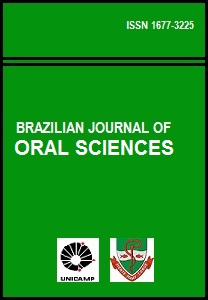Abstract
Aim: To evaluate the clinical performance of a composite resin (CR) and a resin-modified glassionomer cement (RMGIC) for the treatment of abfraction lesions. Methods: Thirty patients with abfraction lesions in at least two premolar teeth were selected and invited to participate in this study. All restorations were made within the same clinical time frame. One tooth was restored with CR Z100TM (3M, St. Paul, MN, USA), and the other was restored with RMGIC VitremerTM (3M). The restorations were assessed immediately and 1, 6 and 12 months after the restoration, using modified US Public Health Service (USPHS) criteria: marginal integrity, marginal discoloration, wear, retention, secondary caries and hypersensitivity. The statistical analysis was based on Friedman ANOVA test and Mann-Whitney test, considering p<0.05 for statistical significance. Results: Both materials demonstrated satisfactory clinical performance after one year. In the individual analysis of each material, there was a significant difference (p<0.05) in the criteria marginal integrity and wear, for both CR and RMGIC. RMGIC exhibited more damage one year after the restoration. Comparing both materials, it was found a significant difference only for marginal discoloration, while the RMGIC restorations showed the worst prognosis after a year of evaluation. There was no significant difference in the number of retentions, caries or hypersensitivity between CR and RMGIC. Conclusions: It was concluded that CR exhibited the best clinical performance according to the cost-effectiveness and evaluation criteria used in this study.

This work is licensed under a Creative Commons Attribution 4.0 International License.
Copyright (c) 2016 Fabianna da Conceição Dantas Medeiros, Marquiony Marques Santos, Isaac Jordão de Souza Araújo, Isabela Pinheiro Cavalcanti Lima

